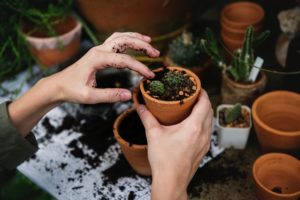Is this the year you and your family will plant your first garden?
There are so many benefits from planting your own garden. It’s an activity the whole family can participate in outdoors, not to mention that it’s just plain cool to be able to eat food you grew yourself!
But if you have never planted a garden before, where do you even start? There are many options for setting up a garden. From container gardening to raised beds to right in the ground, there are many possibilities – each has advantage and disadvantage, so it’s a matter of educating yourself to see what will work best for you and your family’s lifestyle.
Here’s the scoop on container gardening, which may be a fun and easy way to start if you’ve never gardened before.
Container Garden
What is it? A container garden is a nice option if you don’t have much of a backyard (or maybe no yard at all!) – many types of plants will thrive in planters set out on your patio, balcony or porch. This option is also good for individuals with physical limitations who may not be able to kneel down on their hands and knees.
What types of vegetables? Carrots, radishes, tomatoes, lettuce, herbs (such as basil), cucumbers, peppers, eggplant, green onions, squash as well as any vegetable plant that offers a continuous supply of produce. Check space requirements on the seed packet or tag, so you can avoid the larger varieties of vegetables.
What supplies are needed?
- Planting containers – While you can use many types of planters, just ensure that the planter has 1) a wide opening, 2) drainage holes in the bottom and 3) has a shape that is not too tapered at the bottom. Here are some planter ideas (which you may have around your house already): glazed ceramic planters, tubs, plastic storage bins, bushel basket, plastic garbage can, cut off milk jugs or 5-gallon planters. Be sure to plant larger vegetable plants in larger planters – vegetables such as tomatoes do much better in a higher capacity planter.
- Soil – Be sure to buy a high-quality soil which is made for planting vegetables.
- Fertilizer – Make a ready-made solution and fertilize your vegetable plants according to the package directions.
- Drainage – Your planter must have good drainage so that the soil doesn’t stay saturated with water. Drill holes in the bottom if necessary. Buy a plastic saucer to keep water from damaging your patio. Use some sort of drainage media in the bottom of the planter to help with drainage – this can be gravel (not recommended in a large planter because it will add a lot of weight), leca pellets (clay balls, can be found at local hydroponics stores), or even styrofoam peanuts.
- Stakes – For taller growing plants, such as tomatoes, be sure to use stakes and tie the plant to the stake with twine. You can also anchor the plant to a patio railing so that it is a little more stable.
- Watering – Keep in mind that planters will dry out faster than plants grown in the ground. Keep those plants well watered, especially in the hot summer months.










